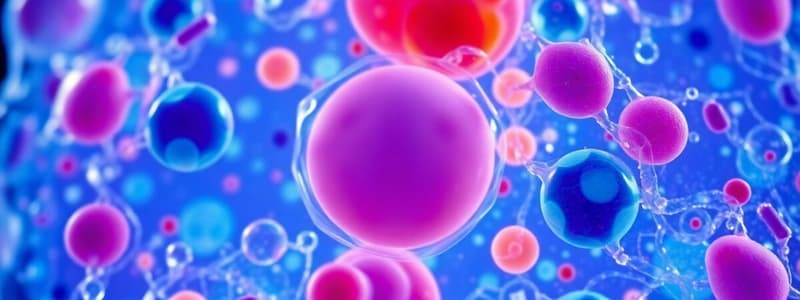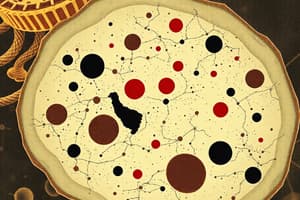Podcast
Questions and Answers
What is found inside the cell and contains all the other cell structures?
What is found inside the cell and contains all the other cell structures?
- Cytoplasm (correct)
- Cell wall
- Cell membrane
- Nucleus
What separates the nucleus from the cytoplasm?
What separates the nucleus from the cytoplasm?
- Nuclear membrane (correct)
- Cell membrane
- Vacuole
- Cell wall
What surrounds the cell?
What surrounds the cell?
- Nuclear membrane
- Cell wall
- Cell membrane (correct)
- Cytoplasm
What is the cell wall made of?
What is the cell wall made of?
In what type of cell is a cell wall found?
In what type of cell is a cell wall found?
What are the organelles in the cytoplasm packed with chlorophyll?
What are the organelles in the cytoplasm packed with chlorophyll?
What is the function of vacuoles?
What is the function of vacuoles?
In plant cells, what large vesicles take up a large part of the interior?
In plant cells, what large vesicles take up a large part of the interior?
Which of these structures is visible in almost all cells when using an electron microscope?
Which of these structures is visible in almost all cells when using an electron microscope?
Which structure is the site of aerobic respiration in a cell?
Which structure is the site of aerobic respiration in a cell?
What is the function of ribosomes in a cell?
What is the function of ribosomes in a cell?
What do cells use to safely transport substances from one part of the cell to another?
What do cells use to safely transport substances from one part of the cell to another?
What process do cells undergo to develop specialized characteristics?
What process do cells undergo to develop specialized characteristics?
What is the function of the cilia in ciliated cells?
What is the function of the cilia in ciliated cells?
What is the function of a nerve cell?
What is the function of a nerve cell?
What is the function of a red blood cell?
What is the function of a red blood cell?
What does the acrosome in a sperm cell contain?
What does the acrosome in a sperm cell contain?
Which specialized plant cell absorbs water and mineral ions from the soil?
Which specialized plant cell absorbs water and mineral ions from the soil?
What is the main function of palisade mesophyll cells?
What is the main function of palisade mesophyll cells?
What is transported through xylem vessels?
What is transported through xylem vessels?
Flashcards
What is Cytoplasm?
What is Cytoplasm?
The material within a cell, excluding the nucleus. It holds other cell structures.
What is the Nucleus?
What is the Nucleus?
An organelle that contains chromosomes and controls cell activities.
What is the Nuclear Membrane?
What is the Nuclear Membrane?
A structure surrounding the nucleus, separating it from the cytoplasm.
What is the Cell Membrane?
What is the Cell Membrane?
Signup and view all the flashcards
What is the Cell Wall?
What is the Cell Wall?
Signup and view all the flashcards
What are Chloroplasts?
What are Chloroplasts?
Signup and view all the flashcards
What are Vacuoles?
What are Vacuoles?
Signup and view all the flashcards
What are Mitochondria?
What are Mitochondria?
Signup and view all the flashcards
What are Ribosomes?
What are Ribosomes?
Signup and view all the flashcards
What is Endoplasmic Reticulum?
What is Endoplasmic Reticulum?
Signup and view all the flashcards
What are Vesicles?
What are Vesicles?
Signup and view all the flashcards
What are Specialised Cells?
What are Specialised Cells?
Signup and view all the flashcards
What is Differentiation?
What is Differentiation?
Signup and view all the flashcards
What are Ciliated Cells?
What are Ciliated Cells?
Signup and view all the flashcards
What are Nerve Cells?
What are Nerve Cells?
Signup and view all the flashcards
What are Red Blood Cells?
What are Red Blood Cells?
Signup and view all the flashcards
What are Sperm Cells?
What are Sperm Cells?
Signup and view all the flashcards
What are Egg Cells?
What are Egg Cells?
Signup and view all the flashcards
What are Root Hair Cells?
What are Root Hair Cells?
Signup and view all the flashcards
What are Xylem Vessels?
What are Xylem Vessels?
Signup and view all the flashcards
Study Notes
Organisation of the Organism
- Focuses on cell structure, specialised cells, levels of organisation, and size of specimens.
Cell Structure & Organisation
- Cytoplasm contains all other cell structures inside the cell.
- A nuclear membrane surrounds the large nucleus, separating it from the cytoplasm.
- The cell membrane surrounds the cell.
- Plant cells have a cell wall made of cellulose that surrounds the cell membrane.
- Chloroplasts are organelles in the cytoplasm that contain chlorophyll.
- Vacuoles are large vesicles that compose a large part of the plant cell interior.
- Mitochondria are organelles scattered throughout the cytoplasm.
- Ribosomes are structures either free in the cytoplasm or attached to endoplasmic reticulum.
- Rough Endoplasmic Reticulum (R.E.R.) contains ribosomes. Vesicles are structures moving throughout the cytoplasm.
Cell Structures and Functions
- Nucleus: Contains chromosomes to control how cells grow, work, and divide.
- Cytoplasm: Supports cell structures, facilitates chemical reactions, and contains water and solutes.
- Cell Membrane: Holds the cell together and controls substance movement.
- Cell Wall: Provides support and defines the cell's shape.
- Chloroplasts: Facilitate photosynthesis, using chlorophyll to absorb light energy.
- Vacuole: Contains cell sap, stores various materials, and supports cell shape.
- Mitochondria: Aerobic respiration occurs here, providing energy; more reactions mean more mitochondria.
- Ribosomes: Site for protein production.
- Vesicles: Transport substances between cell parts.
Specialised Cells
- Specialised cells have specific characteristics for particular functions, controlled by genes in the nucleus.
- Cells differentiate to gain necessary structures and characteristics for their roles.
Examples of Specialised Cells in Animals
- Ciliated cell: Cilia move mucus containing trapped particles out of the trachea and bronchi.
- Nerve cell: Long to reach different body parts, possessing extensions to communicate with other cells, insulated by a fatty sheath for faster impulse transmission.
- Red blood cell: Biconcave shape maximizes oxygen diffusion, contains hemoglobin to bind and transport oxygen, and lacks a nucleus to carry more hemoglobin.
- Sperm cell: Head contains a haploid nucleus for fertilization; acrosome has digestive enzymes; mid-piece packed with mitochondria for energy; tail enables swimming.
- Egg cell: Contains nutrient-rich cytoplasm for early embryo growth and a haploid nucleus for fertilization; membrane changes post-fertilization to prevent further sperm entry.
Examples of Specialised Cells in Plants
- Root hair cell: Absorbs water and mineral ions with an increased surface area due to root hairs, thin walls for quick water passage, and no chloroplasts.
- Xylem vessel: Conducts water and supports the plant, forms continuous columns as cells die, lack organelles. Lignin thickens cell walls.
- Palisade mesophyll cell: Column-shaped to absorb sunlight and packed with chloroplasts for maximum photosynthesis.
Levels of Organisation
- Cells: Basic units in organisms.
- Tissues: Similar cells performing the same function
- Organs: Different tissues working together with specific functions.
- Organ Systems: Organs with related functions working together.
- Shoot System: Leaf, stem, flower and fruit with tissues like epidermis, mesophyll, xylem and pholem
- Root System: Root and tuber with tissues xylem, pholem and ground tissue
- Digestive System: Esophagus, stomach, and intestines with tissues muscle, connective, nerve, and epithelial
- Circulatory System: Heart, veins, and arteries with tissues muscle, connective, nerve and epithelial
- Immune System: Thymus and spleen with bone marrow tissue
- Respiratory System: Trachea, bronchi and lungs with connective, muscle and epithelial tissue
- Excretory System: Liver, kidney, skin and lungs with muscle, connective, epithelial and nerve tissue
- Nervous System: Brain and spinal cord with nerve tissue
- Reproductive System: Ovary, cervix, uterus, vagina, testes and penis with muscle, connective, nervous and erectile tissue
Calculating Magnification & Specimen Size
- Magnification is calculated using the formula: Magnification = Image Size / Actual Size.
- To calculate another value becomes easier using the equation triangle.
- Magnification lacks units.
- 1 cm = 10 mm
- 1 mm = 1000 μm
- 1 cm = 10,000 μm
Studying That Suits You
Use AI to generate personalized quizzes and flashcards to suit your learning preferences.




